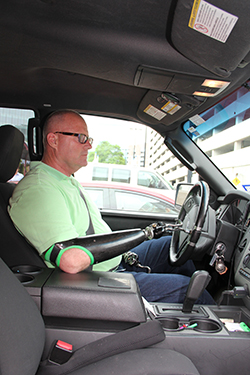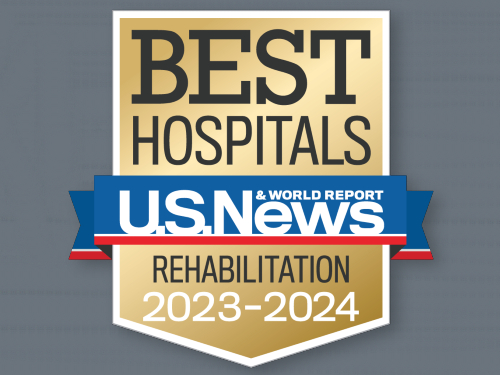A bilateral amputee benefits from the TIRR Memorial Hermann Limb-Loss Program

Scott Carriker was in a bucket truck, changing out an electric utility circuit pole, when he grabbed the wrong wire and suffered an electrical injury that badly burned both his hands.
“I had 7,200 volts go in one hand and out the other and couldn’t let go of the wire,” says Carriker, who works for a company that contracts with power utilities in the Houston area. “Another guy was in the bucket with me. He grabbed me by the collar and pulled me away. I knew my hands were ruined.”
During transport by Memorial Hermann Life Flight® to the Red Duke Trauma Institute at Memorial Hermann-Texas Medical Center, formerly known as Texas Trauma Institute at Memorial Hermann-Texas Medical Center, Carriker went into cardiopulmonary arrest and was defibrillated. He was admitted to the hospital’s John S. Dunn Burn Center and underwent eight surgeries in 10 days, the last two of which were amputations of both arms below the elbow.
“While I was in the hospital, it became apparent to me that my hands would never be useful, even though they said they might be able to keep one looking like a hand,” he says. “I knew I’d be facing another couple of years of surgeries if I made that choice. My other option was amputation. In six months I’d be on my way back into life. Form follows function. I told them to whack ‘em.”
He credits physical medicine and rehabilitation specialist Danielle H. Melton, MD, director of the Limb-loss Program at TIRR Memorial Hermann, with providing the information he needed to make that decision. Consulted by his surgeons, Dr. Melton met with Carriker in his hospital room. As with all her patients, she educated Carriker and his family about prosthetics and long-term outcome goals, and gave guidance to the surgeons about the level of amputation.
“Going through an amputation and getting a prosthesis is such an overwhelming process for patients,” says Dr. Melton, an assistant professor in the department of Orthopaedic Surgery at McGovern Medical School at The University of Texas Health Science Center at Houston (UTHealth). “In the beginning they don’t have any concept of where to turn for help or what life will be like going forward. If the family is there when I visit, I can walk everyone through the process together. There are always questions: How do I get a prosthesis? How long will it take to learn to use it? How do I find the right therapist? When will I be able to return to work? What kind of activity restrictions will I have?”
Because Memorial Hermann-TMC operates one of the busiest trauma centers in the nation, 60 to 80% of the limb-loss patients Dr. Melton sees have suffered traumatic injury to a limb. By contrast, the demographics of amputees across the United States are almost exactly reversed – about 80% undergo amputation for vascular conditions.
“Like Scott, my patients tend to be younger and healthier,” she says. “Most are in the prime of life, and many are concerned about activity-specific prostheses for running, swimming or other sports. I provide information and make recommendations, but the choice of the prosthetics company is the patient’s.”
Carriker’s goal was a quick return to work. Through Dr. Melton he learned about Advanced Arm Dynamics and scheduled a meeting with a company representative before making the decision to amputate.
“I asked them, ‘Do you just have a great website, or can you really bring it?’” he says. “They gave me a plan, and Dr. Melton got involved with my surgeon to make sure they were leaving my arms in the best way possible for the prosthesis.”
Following his discharge from Memorial Hermann-TMC, Dr. Melton and her team saw Carriker in the Limb-loss Clinic at TIRR Memorial Hermann. “We like to see patients as soon as they’re discharged from the hospital,” says Kristin Reeves, PT, MSPT, coordinator of amputee services for the Limb-loss Program. “If they have wound-care needs, we can help. Once they choose a prosthetics company, we are very specific with the components we prescribe. After they have their prosthesis, we refer them to a knowledgeable, experienced therapist who will teach them to use their device correctly with the least expenditure of energy.” After his arms healed, Carriker went to Advanced Arm Dynamics a few times a week to begin the process of learning to use his prosthetics. He was fitted with the myoelectric I-Limb Revolution, which has five digits that move independently, bending at the natural joints to fit around the shape of the object grasped.
Custom made to fit and attach to the remaining limb, myoelectric prosthetics use electronic sensors to detect muscle and nerve activity and translate the information into impulses that control movement. The result is a limb moved by the mental stimulus of the user, who can control the strength of grip and speed of movement.
Today, Carriker has two options: a set of robotic hands and a set of hooks that attach to his prostheses. “I use the hooks all day long,” he says. “The robotic hands are very cool, but if you need to do anything with force, you need the hooks. With them, I’m completely self-sufficient.”
He returned to work in October 2014, six months after his injury. Formerly the foreman of a construction crew, he was promoted to operations coordinator and supervisor by his employer, who valued his 33 years of experience in the field.
“Scott has done extremely well,” Dr. Melton says. “He worked hard to master the devices he chose and exceeded our expectations. He did a phenomenal job in a very efficient manner. Because he’s such a positive role model, we’ve asked him to serve as a peer visitor to limb-loss patients in the hospital.”
Originated by the nonprofit Amputee Coalition of America, the Certified Peer Visitor (CPV) Program offers people with limb loss the opportunity to go through formalized training to develop the skills they need to support new patients, offering encouragement and information at a pace they can absorb. TIRR Memorial Hermann was one of the first institutions in the country to partner with the coalition’s CPV program.
“I use the peer visitors because they’re well trained to handle even the most difficult questions the patient and family may ask,” says Dr. Melton, who has served as chairman of the Amputee Coalition’s Scientific Medical Advisory Committee for the past two years. “There’s no ethical conflict because they’re not employed by a company that sells prosthetics. We try to match peer to patient by socioeconomic background, age and situation to give patients someone they can make a connection with. The peers are a great resource for us. I’m happy that TIRR has been such a tremendous supporter of the program.”
Carriker currently sees Dr. Melton every three months at the TIRR Memorial Hermann Outpatient Medical Clinic. “Because limb loss is a lifelong process, I follow most patients for the rest of their lives,” she says. “After the first year, we see them at least annually to ensure that their prosthesis is functioning correctly and to manage any long-term complications that may arise as a result of amputation. Our clinic is team based, with access to prosthetics, physical therapy, occupational therapy, nursing, psychology and social work. We also close the loop with the surgeon and provide any other follow-up care patients may need.”
The Limb-loss Program also helps ensure that patients secure funding for their prosthesis. “This is a huge component of what we do for patients,” Kristin Reeves says. “Insurers require proper documentation to authorize a prosthesis. Because we’re attuned to what insurers need, our track record of getting approval is excellent. Many come to our clinic because their prosthetist referred them to ensure proper documentation for insurance.”
Kacee Pavelka was in the petroleum engineering program at Texas A&M University when she lost her dominant arm in an auto accident. A former patient of Dr. Melton’s, she now serves as her medical assistant.
“Because amputation is a life-changing event, we look at the whole person and work to resolve any issues that stand in the way of returning to a fully functional lifestyle,” Pavelka says. “We provide psychological services to help with the ups and downs of life after limb loss and also provide nutrition and dietary counseling. Many patients have issues related to the increase in energy expenditure a prosthesis requires, or weight gain issues from the loss of mobility. The most important part for me, having sat in the same chair myself, is validation of patients’ feelings as they go through the process. We want them to know that limb loss doesn’t stand in the way of accomplishment.”
Pavelka and Carriker are living proof. He describes Dr. Melton and her team as “my guiding force. If I need anything, they’re always there. I made the decision to amputate because I wanted to move on with my life. I always believe in moving on to the next thing. I’m not at home crying all the time, and a lot of that is because of the healthcare professionals in my life, who gave me a vision for my future. They pointed me toward a foreseeable and attainable future. My life didn’t end. It just changed.”

Nationally Ranked Rehabilitation
For the 34th consecutive year, TIRR Memorial Hermann is recognized as the best rehabilitation hospital in Texas and No. 4 in the nation according to U.S. News and World Report's "Best Rehabilitation Hospitals" in America.
Learn More